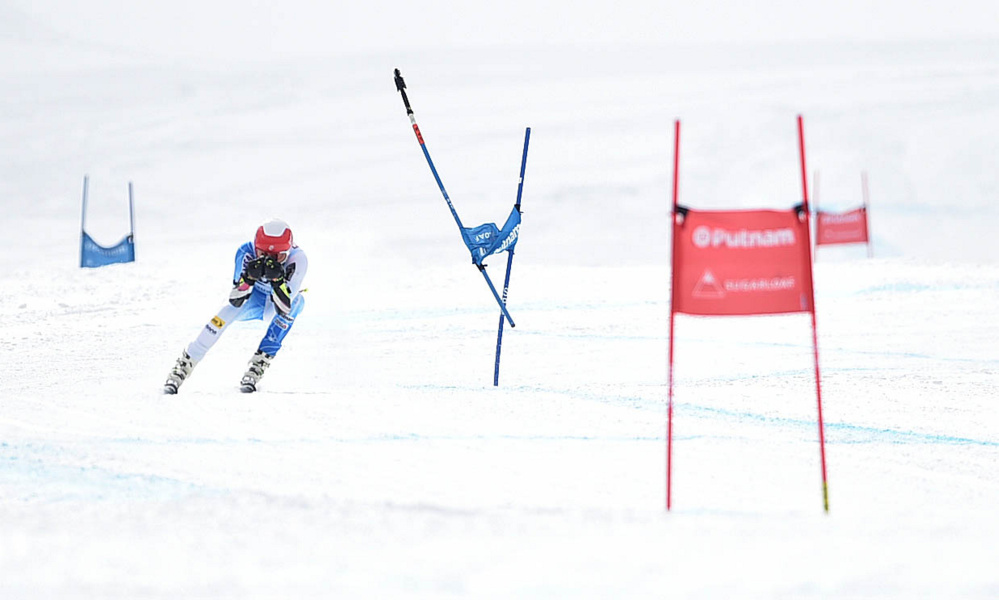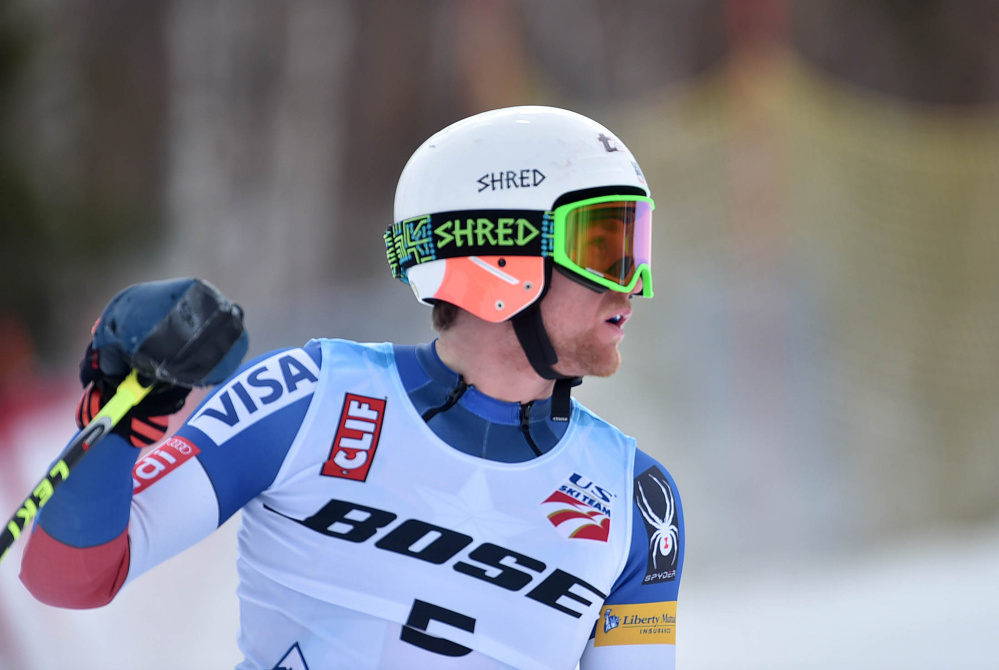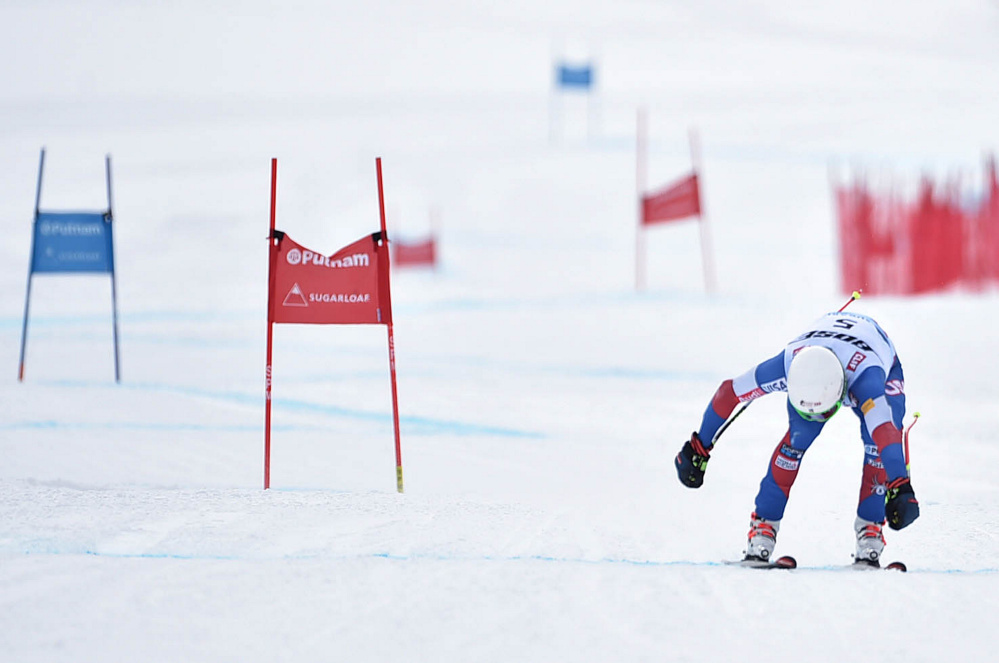CARRABASSETT VALLEY — Storm Klomhaus pulled off her goggles, and her eyes were wide. Klomhaus had just finished her super G run at the U.S. Alpine Championships, and the 18-year old looked like she was happy it was over.
“I did not like that,” Klomhaus said to anybody within earshot.
Klomhaus was certainly not alone. The super G was the first race of the four-day U.S. Alpine Championships, which will take place through Tuesday at Sugarloaf, and the sometimes icy, often steep Narrow Gauge course was challenging. Thirteen women did not finish their run, while six men did not complete the race.
The super G is this: How close can you get to skiing too fast to maintain control? Can your body make decisions before your brain realizes it has to? On Saturday, there was no time to admire the view of Carrabassett Valley as you made your way down the mountain. On the nicest day, Narrow Gauge is a challenging course. On Saturday, with Friday’s fresh snowfall and early morning fog at the peak delaying the start of racing, Narrow Gauge was a tough course made even tougher.
“There’s a couple spots that are fairly difficult. Coming in before the main pitch up there is a tough turn. The pitch is challenging. There’s some good turns down here,” veteran Tim Jitloff said after his run. “Obviously, this bottom flat is really slow, so you’ve got to know how to glide real well. There’s a lot of skills coming in play.”
Jitloff finished in 12th place, not bad for a guy who admittedly hasn’t skied the super G much recently. Jitloff estimated his top speed Saturday was between 65 and 70 miles per hour.
“That’s about as fast as I’ve gone all year. All I know is, it’s a lot of fun. mid-to-high 60s.
“You’ve got to have a lot of trust,” Jitloff said. “When I was doing some World Cup super G’s, you never get really comfortable because anything can happen. You do get to a certain point where you trust it and go.”
Laurenne Ross won the women’s super G national title Saturday, with a run of 1:21.44. The speed is what has always made Ross gravitate to the super G, making it one of her favorite events. Ross recalled her first time trying the super G, at a race in Montana years ago.
“From that point, I knew that was what I wanted to do,” Ross said. “I just remember the rush of being on longer skis. I was on a men’s World Cup GS ski or something that I had borrowed, and I just remember going so fast and having so much fun. The thrill of it, it being so exhilarating. It’s really addictive.”
At the speeds needed to be successful in the super G, you need a plan, and you need muscle memory. For younger skiers like Carrabassett Valley Academy junior Sam Conzelman, 17, learning on the stage of the national championships is thrilling. Although she trains at Sugarloaf all winter, Saturday’s super G course was longer than Conzelman is used to. The turns were bigger than she is used to. Everything was bigger than she was used to.
“Honestly, for the most part, you’re thinking about staying in the whole course,” said Conzelman, who in her first national championship race on her home mountain finished in a respectable 19th place. “Every turn, it’s ‘Oh my God, I’m not going to make this gate.'”
Carrabassett Valley native and U.S. Ski Team member Sam Morse placed fourth in the men’s race with a time of 1:20.22, just over a half-second behind winner Ryan Cochran-Siegle’s 1:19.66. Morse reacted on instincts throughout his run.
“It’s pretty much all subconscious at this point. You don’t have time to really think. You execute tactfully, but skiing-wise, it’s either there or it’s not. At this time of year, you’ve got to be going with what you have, what your body knows,” Morse said.
Getting to that point, where it feels like the brain lets the body run in high velocity cruise control, is the goal. At the national championships, you see some skiers who are at that point, like Morse and Ross, and some who are getting there, like Conzelman.
“I’m one of the older guys. I’ve done really no super G this year, so I’m relying on muscle memory,” Jitloff said. “It’s a learning experience for the younger kids. The older guys will come out here and they’re using the foundational skills they’ve built over the years. It’s a challenging course. It’s not easy to be fast here.”
When things are going well, skiing 65 miles per hour feels like slow motion.
“It depends on what kind of section you’re in. If you’re in a pretty easy, flowy section, it doesn’t even feel that fast. It feels really flowy and really fun,” Ross said. “I still have to think about what I have to do. I sometimes forget about that in my races and I try to just rely on my natural skiing, but if I approach a race without aggression, I’m slow not matter what. I’m learning every day, no matter what race it is, I still have to push it.”
Young skiers will learn that. There’s a trust that comes with experience, Jitloff said. It can’t be second nature when it’s your first time.
“Often times in super G, you make a game plan. You estimate in your mind how it’s going to be. You have a pretty good idea. I’m telling you from my past experience, it’s often a you’re figuring it out when you get there kind of thing. You have to be the master of your ability to adapt. That’s key,” Jitloff said. “You can make it down alive and be slow, but to be real fast, you’ve got to trust it.”
Travis Lazarczyk — 861-9242
Twitter: @TLazarczykMTM
Send questions/comments to the editors.





Success. Please wait for the page to reload. If the page does not reload within 5 seconds, please refresh the page.
Enter your email and password to access comments.
Hi, to comment on stories you must . This profile is in addition to your subscription and website login.
Already have a commenting profile? .
Invalid username/password.
Please check your email to confirm and complete your registration.
Only subscribers are eligible to post comments. Please subscribe or login first for digital access. Here’s why.
Use the form below to reset your password. When you've submitted your account email, we will send an email with a reset code.